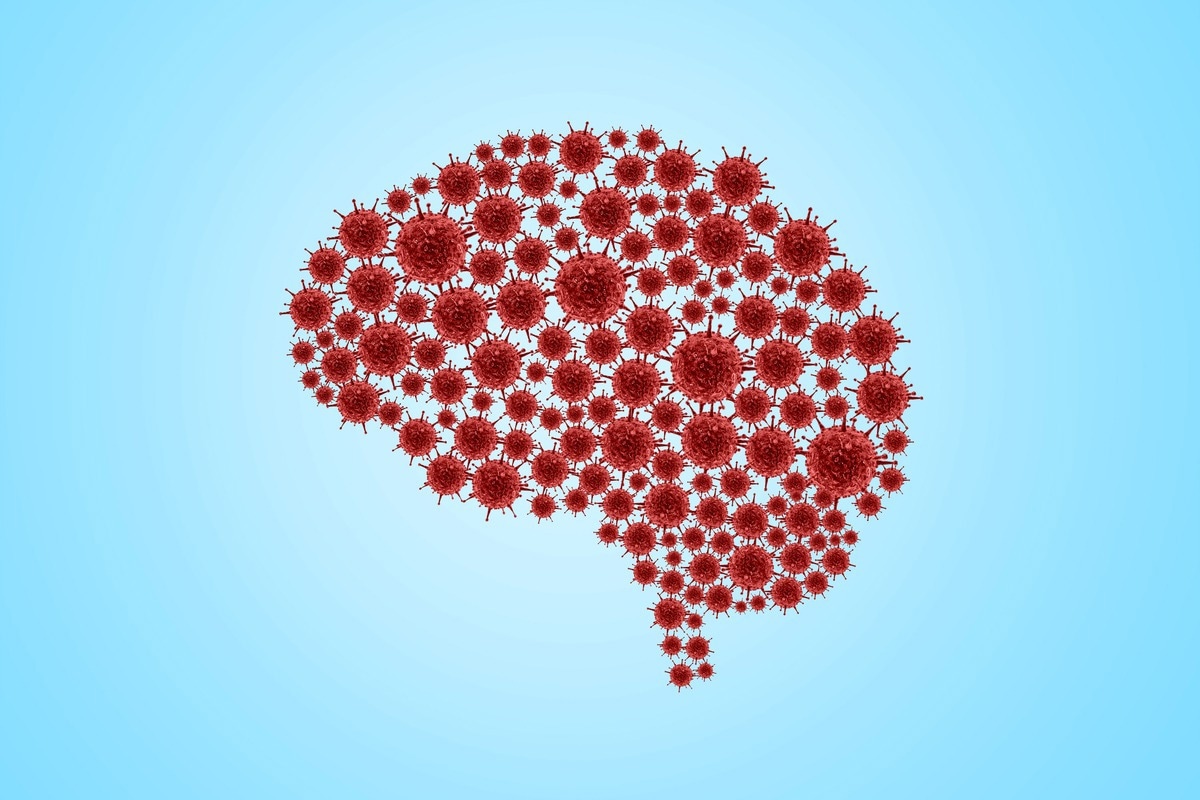In a recent review published in Immunity, researchers explored potential mechanisms of neuro-immune pathophysiology of severe acute respiratory syndrome coronavirus 2 (SARS-CoV-2) infections.
 Study: What SARS-CoV-2 does to our brains. Image Credit: DOERS/Shutterstock
Study: What SARS-CoV-2 does to our brains. Image Credit: DOERS/Shutterstock
Background
Studies have reported on the development of unspecific neurological symptoms in the acute coronavirus disease 2019 (COVID-19) phase, such as dizziness, fatigue, weakness, nausea, and headaches, and specific symptoms such as anosmia and dysgeusia in the post-acute COVID-19 phase.
However, evidence of SARS-CoV-2 replication in the central nervous system (CNS), sickness behavior, and cognitive impairments post-COVID-19 is lacking. Furthermore, one symptom could have several causes, which cannot be ascertained by self-reported data analyzed in previous studies.
About the review
In the present review, researchers explored potential neuro-immune pathways for the development of SARS-CoV-2-associated neurocognitive symptoms and structural or functional CNS alterations during the acute and post-acute phases of COVID-19. They also reviewed existing data (including in vitro studies) on SARS-CoV-2 affinity for CNS and the pathways that cause sickness behavior.
SARS-CoV-2 affinity for the central nervous system
Previous case reports demonstrated SARS-CoV-2 ribonucleic acid (RNA) within the CNS or the cerebrospinal fluid (CSF); however, case series’ have not reported SARS-CoV-2-RNA presence or elevation in the leukocyte count in CSF in acute COVID-19 patients. Furthermore, overt SARS-CoV-2 particles have not been detected within the brain by electron microscopy.
Receptors of cytokines such as tumor necrosis factor (TNF), interleukin (IL)-6,1α, and 1β are present on the blood-brain barrier (BBB). SARS-CoV-2 RNA could be present in the CNS due to contamination from blood subsequent to altered BBB permeability after systemic inflammation and the cytokine storm. The resultant cytokine-induced toxicity in the brain leads to cognitive decline.
Elevated intrathecal expression of IL-6, 8, 15, and macrophage inflammatory protein- 1 beta (MIP-1β) have been reported in BBB disruption cases. Immune cells could also migrate from the peripheral blood following SARS-CoV-2 opsonization (Trojan horse theory). Further, autoantibodies against glial and neuronal antigens and clinical signs of extrafollicular B lymphocyte activation have been detected among patients with critical COVID-19 with pronounced neurological symptoms.
Histological investigations of dead COVID-19 patients have revealed scarce CD8+ T lymphocytes in CNS parenchymal cells; however, elevated T lymphocyte counts close to microglial nodules and in the perivascular niche have been found. In addition, a study reported damaged astrocytes and neurons in severe COVID-19 cases; however, the study lacked control groups for comparison, and similar observations are also associated with hypoxia, septic shock, polypharmacy, altered metabolism, and invasive therapies. Microglial and astrocyte activation (innate immune mechanisms) was not positively correlated with the SARS-CoV-2 RNA levels in the brain of dead COVID-19 patients. Such activation has also been observed in patients with dementia and sepsis.
Association between the neuroimmune axis and sickness behavior
Sickness is associated with decelerated cognitive functions and reduced sensitivity to external stimuli. Sickness behavior affects mood, drive, and motivation, resulting in social isolation and thereby contributing to energy savings for fighting the infection. In accordance with this, it has been found that viral loads among individuals with asymptomatic and symptomatic SARS-CoV-2 infections were similar; however, SARS-CoV-2 was eliminated faster in asymptomatic cases.
Sickness behavior is not SARS-CoV-2-specific and can be observed among patients with systemic autoimmune disorders such as systemic lupus erythematosus (SLE), with underlying chronic inflammatory changes such as robust type I interferon (IFN) expression. IFN responses to viruses with single-stranded (ss) RNA (such as SARS-CoV-2) or double-stranded RNA (dsRNA) ligands of the epithelial and endothelial brain cells have been found to mediate depression-like sickness behavior.
IFN-β administration has been associated with reduced memory recall and reduced spatial learning, mediated by chemokines [C-X-C motif chemokine ligand 10 (CXCL10) and chemokine receptor 3 (CXCR3)] produced in the epithelial and endothelial brain cells. In vitro studies have reported that IL-1 or lipopolysaccharides (LPS) administration induces the cytokine receptor expression in the CNS among rodents and subsequently leads to sickness behavior, which can be reversed by insulin-like growth factor I (IGF-I) and IL-10 administration.
Lymphocytic choriomeningitis virus (LCMV) infection-induced IFN-I signaling in mice negatively impacted tissue repair mechanisms and neurological function recovery from post-traumatic cerebrovascular injuries. LCMV infections were also associated with persistently increased BBB permeability, mediated by melanoma differentiation-associated protein 5 (MDA5) and IFN-α/β receptor (IFNAR), and socially isolated mice showed reduced IFN-γ expression.
Association between the neuroimmune axis and critical illnesses in post-viral syndromes
Acute infection symptoms such as pain, fatigue, and neurocognitive impairments (impaired memory, reduced drive, and motivation, difficulties in concentration) could last for several weeks, months, or years post-acute phase resolution of viral infections, referred to as the post-viral syndrome. The authors suggest that long COVID is similar to other post-viral syndromes, and CNS symptoms in long COVID could be due to the continued exposure to or production of pro-inflammatory cytokines by CNS cells (astrocytes, microglia, endothelial cells) despite resolution of acute inflammation.
Fever, medications (analgesics, antibiotics, sedatives), comorbidities, immobility, organ dysfunctions, social isolation, and artificial nutrition affect the CNS, particularly in patients with severe COVID-19. SARS-CoV-2-associated pneumonia, acute respiratory distress syndrome (ARDS), and cytokine-induced dysregulated homeostasis of the ion channels of brain cells further challenge the function of neurons. However, conditions causing sepsis and encephalopathy are also associated with long-term cognitive impairments.
Conclusion
To summarize, the substantial inflammation in the CNS with the absence of evidence for active SARS-CoV-2 replication in the CNS suggests that neurocognitive symptoms in the acute or post-acute COVID-19 phases are most likely due to indirect neuroimmune effects rather than direct effects of SARS-CoV-2 neurotropism.